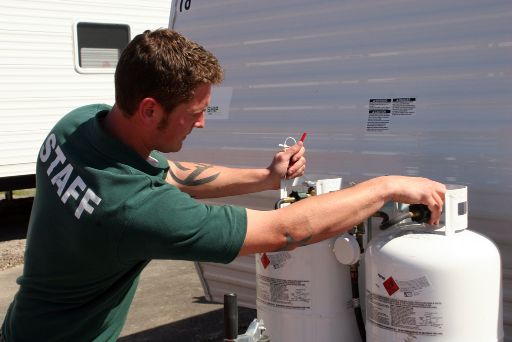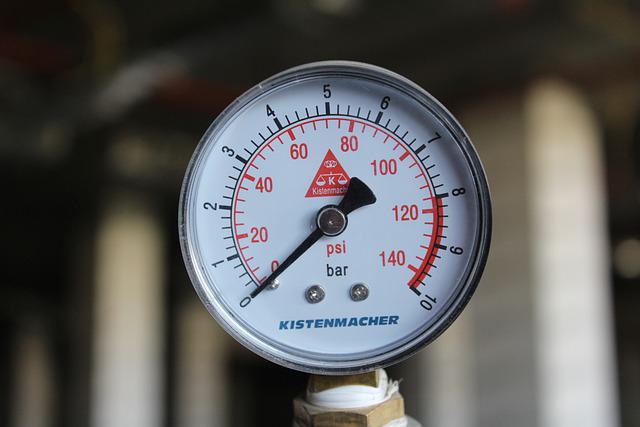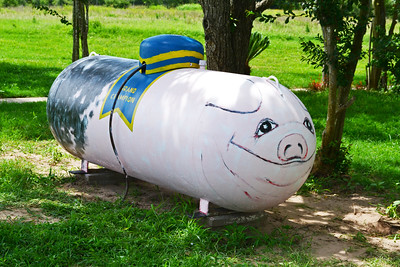
Most people are aware that a propane tank needs to be installed on level ground, but few know that a concrete pad is often required. While the size and thickness of the pad will vary depending on the specific installation, most propane tanks need to be installed on a concrete pad that is thick. This helps to provide a stable foundation for the tank and prevents it from sinking into the ground over time. While a concrete pad is not always required, it is always recommended.
Ultimately, it is up to the manufacturer to determine what type of foundation their products need. If you are unsure whether or not your propane tank needs a concrete pad, the best course of action is to consult with the manufacturer or your local propane provider. They will be able to give you specific instructions for your situation.
Installation of above-ground propane tank does require a concrete pad, and it is recommended. A concrete pad will provide a level, stable surface for your tank and will help protect it from weather damage and corrosion.
Why Consider a Concrete Pad?
Propane tanks, while incredibly useful, also come with a set of requirements to ensure they operate safely and efficiently. One of these considerations is the base or foundation on which they rest. While there are multiple options available, a concrete pad is often a top choice for many reasons. Let’s delve into the specifics of why you might consider a concrete pad for your propane tank.
1. Protection against shifting ground or soil erosion
- Ground Movement: Ground can naturally settle or shift over time, especially in areas with clay-heavy soils or regions that receive large amounts of rainfall. Such movements can place undue stress on a propane tank, potentially causing it to shift or become unbalanced.
- Erosion: Water runoff can lead to erosion around the base of the tank, compromising its stability. A concrete pad acts as a barrier, distributing the weight of the tank evenly and minimizing the risk of the ground beneath the tank eroding away.
2. Improved stability in variable conditions
- Weather Changes: In regions where the weather fluctuates dramatically, the ground can expand and contract, leading to instability. A concrete pad provides a consistent, stable base regardless of the weather conditions.
- Seismic Activity: In areas prone to earthquakes, the ground can move suddenly and dramatically. A concrete pad can help ensure the tank remains in place during such events, reducing potential hazards.
3. Enhanced Safety
- Tank Tipping: An unsecured or poorly founded tank runs the risk of tipping over, especially if it’s a larger, above-ground unit. This can lead to potential gas leaks or even explosions. A concrete pad provides a stable base that reduces the chance of this happening.
- Puncture Risks: If a tank were to tip or shift, it could come into contact with sharp objects or rough terrain. This can lead to punctures, again risking leaks or worse. A concrete pad keeps the tank elevated and away from potential ground hazards.
4. Aesthetic appeal and organization
- Clean Look: Concrete pads provide a clean, organized look to the area around the propane tank. This can be especially important for businesses or homeowners who prioritize the appearance of their exteriors.
- Landscaping: For homeowners, a concrete pad can be incorporated into landscaping designs, ensuring the propane tank area looks neat and is easy to maintain.
While there are other foundation options available for propane tanks, a concrete pad offers a combination of safety, stability, and aesthetic benefits that are hard to match. Whether you’re in an area with shifting soils, dramatic weather changes, or simply want a cleaner look for your property, a concrete pad is a worthy consideration for your propane tank.
[table id=3 /]
Alternatives to Concrete Pads
| Foundation Option | Benefits | Drawbacks |
|---|---|---|
| Gravel or Pebble Bases |
– Drainage: Allows for excellent water runoff. – Flexibility: Easily adjusted or leveled. – Cost: Generally less expensive than concrete. – Easy Installation: Requires less prep work. |
– Maintenance: Can become uneven over time. – Weed Growth: Weeds may sprout up. – Less Stability: Not as stable as concrete. |
| Compacted Soil |
– Natural Look: Blends seamlessly into the landscape. – Cost: No additional materials needed. – Permeability: Allows for some water drainage. |
– Less Stability: Can shift or settle. – Erosion: Vulnerable to rain and water runoff. – Weed Growth: Weeds can grow. |
| Paver Stones |
– Aesthetic Appeal: Enhances visual appeal. – Stability: Offers a stable foundation when installed correctly. – Durability: Long-lasting with minimal maintenance. |
– Cost: More expensive than other options. – Installation Complexity: Requires a level base and is more involved. – Potential for Unevenness: Might become uneven if not installed correctly. |
Specifications of Concrete Pad
When it comes to your propane tank, you want to make sure that it is secured properly. This means having a concrete pad that is the right size for your tank. The dimensions of a propane tank concrete pad will vary depending on the size of your tank.
For a 500 gallon propane tank, the concrete pad should be 4’6” wide by 10’6” long. This will give you enough space to properly secure the tank and have room to work around it. If you have a larger tank, you will need a larger pad. Again, it is best to consult the propane company.
If you are not sure about the size of your propane tank, you can always ask your local propane supplier for help. They will be able to tell you the right size of concrete pad needed for your tank.
There are many specifications that need to be adhered to when pouring a concrete pad. The thickness of the pad is very important. It needs to be at least four inches thick, but no more than six inches. The width and length of the pad will depend on the size of the area you are working with. The grade of the concrete is also important. It should be at least a C30 mix, but no more than a C35 mix.
Anything less than a C30 mix will not be strong enough to support the weight of the vehicle. The concrete pad must also be reinforced with steel rebar. The rebar should be placed in the middle of the pad and extend outward for at least eight inches on all sides.
The purpose of the rebar is to reinforce the concrete and prevent cracking under extreme weight or pressure. It is also important that the concrete pad is level. Any unevenness could cause problems with the structure of your vehicle and make it unsafe to drive on. Use a level when pouring the concrete to ensure that it is evenly distributed. If you follow these specifications, your concrete pad will be safe and durable.
There are a few key specifications to take into account when pouring a concrete pad. The first is the thickness of the pad. A common thickness for a concrete pad is 4 inches, but it can range from 4 to 6 inches. The next specification is the Portland cement type. There are many types of Portland cement, but the most common type used for concrete pads is Type I. The last specification to consider is the aggregate size. The most common aggregate size for concrete pads is 1/2 inch, but 3/4 inch aggregate can also be used.
A propane tank concrete pad must be built to specifications in order to ensure the safety of the tank. The concrete pad must be big enough to support the weight of the tank and must be level. The concrete pad must also have a drain system in place to remove any water that may accumulate around the tank.
Consult with the tank company for the specifications they will be using.
| Specification | Details |
|---|---|
| Recommended thickness and dimensions |
– Small Tanks (20-100 gallons): Typically, a 3.5″ to 4″ thick pad is sufficient. – Medium Tanks (100-500 gallons): A 4″ to 6″ thick pad is recommended with a larger surface area to support the weight. – Large Tanks (500+ gallons): At least a 6″ thick pad, with dimensions exceeding the tank’s footprint for stability. |
| Proper reinforcement |
– Rebar: Steel bars placed in a grid pattern can significantly increase the tensile strength of the concrete. – Wire Mesh: Suitable for smaller pads where heavy loads aren’t expected but still offers added strength. – The choice between rebar and mesh will often depend on the size and weight of the tank and the specific site conditions. |
| Surface preparation and leveling |
– The area should be excavated to remove any organic material, such as grass or plants. – A compacted layer of gravel or crushed stone can aid in drainage and provide a level base for the concrete. – The site should be leveled to ensure the pad is even and that the propane tank will sit level upon it. |
| Importance of curing and maintenance |
– Curing is essential for achieving the concrete’s full strength. It should be kept moist (e.g., by covering with wet burlap) for at least 7 days in most conditions. – Regular inspections for cracks or shifts in the pad are vital. Repair any damage promptly to prevent issues with the propane tank’s stability. – Cleaning and sealing the pad can extend its lifespan and prevent damage from freeze-thaw cycles in colder climates. |
Concrete pad specification for vertical 120-gallon propane tank
When choosing a concrete pad for your vertical 120 gallon propane tank, there are a few things to keep in mind. The pad should be large enough to accommodate the tank without being too large and taking up too much space in your yard. It should also be level and level with the ground around it so that the tank can sit evenly on the pad. The thickness of the pad should be at least 4 inches, but 6 inches is ideal. The concrete should be poured with a 3/4 inch rebar grid for reinforcement.
Its dimensions are 3’5” wide and 3’5” long. To keep the tank firmly in place, the 4 corners of the pad should be installed with eye bolts. The piping system must be located at the center of the pad, from the ground and goes out to the direction of the house.
Cost Implications
1. Estimated Costs of Installing a Concrete Pad
The cost of installing a concrete pad can vary widely based on several factors including the region, labor rates, material prices, and the size of the pad. On average:
- Small Pad (for 20-100 gallons): $200 – $500
- Medium Pad (for 100-500 gallons): $500 – $1,000
- Large Pad (for 500+ gallons): $1,000 – $2,500 or more.
2. Comparison with Alternative Foundation Methods
When considering the initial and long-term expenses of a concrete pad, it’s helpful to compare with alternative foundation methods:
- Gravel/Pebble Base: The initial cost for this method tends to be lower, ranging from $100-$500 based on the size and depth of the base. However, over the long term, there might be expenses related to leveling, weed control, and replacement of the gravel.
- Compacted Soil: This is one of the most cost-effective methods initially, often requiring just labor if the existing soil is used. But over time, the costs can accumulate due to soil erosion, re-compaction needs, and potential instability issues.
- Paver Stones: The initial cost is generally higher, possibly ranging from $300-$1,500 or more, depending on the type and quality of the pavers. Maintenance costs can be minimal if installed correctly, but replacing damaged pavers or re-leveling can add to long-term expenses.
3. Potential Savings from Reduced Maintenance and Enhanced Safety
By investing in a durable foundation like a concrete pad, homeowners can realize savings in several areas:
- Maintenance: Concrete, when properly installed and cured, requires less frequent maintenance than alternative materials, leading to savings over the lifespan of the tank.
- Safety: A stable propane tank reduces the risk of leaks, tipping, or other safety hazards. This can result in potential savings from avoiding costly accidents, property damage, or injury.
Installation Process
1. Step-by-Step Guide on Preparing and Installing a Concrete Pad for a Propane Tank
- Site Selection: Choose a site that’s easily accessible for propane deliveries but also compliant with local regulations regarding distance from structures and property lines.
- Excavation: Remove the top layer of soil, grass, or any organic material from the chosen site.
- Base Preparation: Lay down a 4-6 inch layer of compacted gravel or crushed stone. This aids in drainage and provides a stable base for the concrete.
- Form Setting: Set up wooden forms in the desired size and shape of the pad.
- Reinforcement: Lay down steel rebar or wire mesh for added strength.
- Pouring Concrete: Mix and pour the concrete into the forms, ensuring it’s spread evenly.
- Leveling: Use a screed to level the surface of the concrete.
- Curing: Allow the concrete to cure for at least a week, keeping it moist to achieve full strength.
2. Consideration for DIY vs. Hiring Professionals
- While it’s possible to install a concrete pad as a DIY project, it requires specific tools, materials, and skills. For larger pads or if you’re unfamiliar with concrete work, hiring professionals can ensure a stable, long-lasting foundation.
3. Timeline and Necessary Materials/Tools
- The entire installation process, from preparation to curing, can take 8-10 days. Necessary tools and materials include shovels, wooden forms, gravel, rebar or mesh, concrete mix, a screed, and possibly a concrete mixer if not buying pre-mixed concrete.
To make a conclusion
Propane tanks are a common sight in backyards across America. Many homeowners do not realize, however, that these tanks need to be placed on a concrete pad in order to be used safely. A propane tank concrete pad provides a level surface for the tank to rest on and prevents it from tipping over. This is important because a tipped over tank can release gas into the air and create a fire hazard.
In addition to being a fire hazard, a tipped over propane tank can also cause an explosion. When a tank is full of propane, it is under pressure. If the tank is not resting on a level surface, the pressure can cause it to explode. A concrete pad prevents this from happening by keeping the tank stable.
Without a concrete pad, a propane tank is also more likely to rust. Rust can cause the tank to leak, which is obviously dangerous. A concrete pad protects the bottom of the tank from moisture and keeps it from rusting.
As you can see, there are many reasons why you should place your propane tank on a concrete pad. It is important to be safe when using any type of grill, but especially when using one that uses propane. By following this simple advice, you can keep your family safe and avoid any potential accidents.

Mike is an experienced propane technician with over 15 years of professional experience in the field. He has dedicated his career to helping customers with their propane needs, from installation to maintenance and repair. Together with Jeremy, he co-founded this website to provide useful information and guidance to customers seeking reliable propane services.




